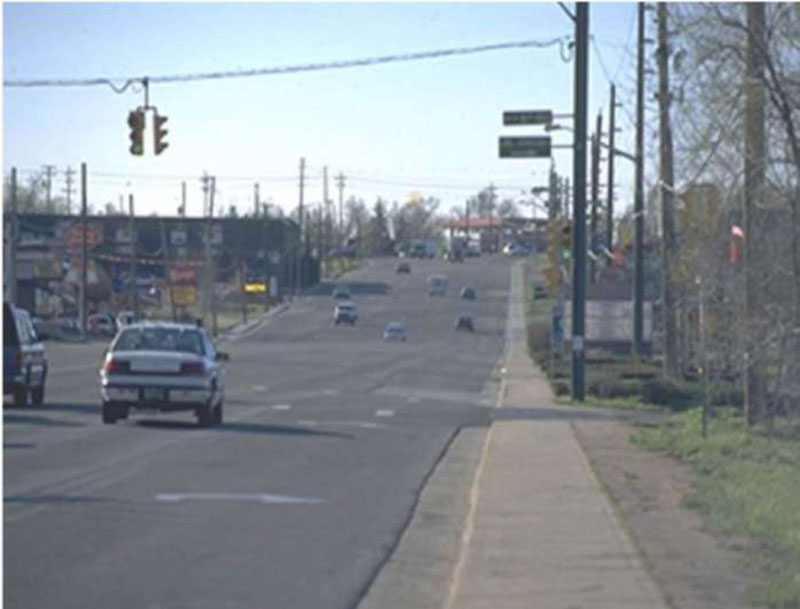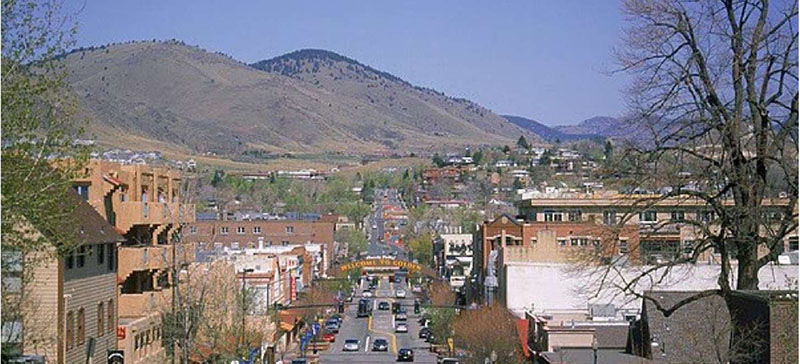(Note: This document has been converted from the original document to 508-compliant HTML. The formatting has been adjusted for 508 compliance, but all the original text content is included, plus additional text descriptions for the images, photos and/or diagrams have been provided below.)
Self-Enforcing Roadways
CITY OF GOLDEN, CO
| ISSUE | STRATEGIES | TAKEAWAYS |
|---|---|---|
|
|
|
Background
A self-enforcing road is a roadway that is planned and designed to encourage drivers to select operating speeds in harmony with the posted speed limit. Properly designed self-enforcing roadways can be effective in producing speed compliance and may contribute to less severe crash outcomes1.
The City of Golden, Colorado is located west of Denver at the base of the Rocky Mountains. It is both a residential community as well as home to the Coors Brewery and Colorado School of Mines. South Golden Road is one of the major arterials in town with a long-standing history of being a major thoroughfare2.
In 1999, plans for a new shopping center along South Golden Road elevated citizens' concerns about traffic speeds as well as pedestrian and bicycle safety along the corridor (see South Golden Road photo).
In response, the city rebuilt South Golden Road using design elements to address speeding, access, and overall safety. The self-enforcing design replaced traffic signals with roundabouts and addressed vulnerable road user safety3.

South Golden Road before improvements. Source: Dan Hartman, City of Golden, CO.

South Golden Road after improvements. Source: Dan Hartman, City of Golden, CO.

Golden, Colorado. Source: Getty Images
The Challenge
Prior to improvement – South Golden Road was a very wide (80 foot) street to cross and consisted of four through lanes plus a center turn lane. The corridor was capable of handling the 20,000 vehicles per day, however, the frequent points of access from business and side streets created operational and safety issues. The half-mile section of South Golden Road included two signalized intersections at Johnson Road and Ulysses Street and two stop-controlled intersections at Lunnonhaus Drive and Utah Street. The corridor was experiencing a number of issues including speeding between intersections, traffic conflicts at intersections for vehicles, pedestrians, and bicycles, and significant delays especially at Utah Street. Prior to improvement, the posted speed limit was 35 mph and the measured 85th percentile speed was 48 mph. The corridor experienced an average of four crashes per month with at least one of these involving an injury3.
Community Input – The city initiated a study that included community input to identify the most viable alternatives for improvement. The study established the following goals for South Golden Road:
- Reduce speed through the intersection
- Improve aesthetics
- Improve access for businesses and residential neighborhoods
- Improve safety
- Create a pedestrian-friendly environment
Design Process – The city considered a range of improvement options, researched roundabout design opportunities, and then gained feedback from the community through public meetings, discussions with businesses, and at public hearings with City Council. The resulting two design options were the following:
- Option 1: Traditional traffic signals with center medians and restricted left turns. This option faced issues as it restricted access to several businesses. In addition, the large intersections were not advantageous for pedestrian and bike crossings.
- Option 2: Modern roundabout section with four roundabouts, narrower roads through using center medians, and restricted left turns. This option was shown to provide improved access for both businesses and vulnerable road users.
The city's efforts led to the ultimate choice for Option 2 (roundabouts) where the design supports speed compliance even with a 25 mph speed limit in addition to enhancing access, operations, and safety for all users. The roundabouts were constructed in 1998 – 1999 and were fully operational in late 1999 (see South Golden Road after improvements photo).
Key Takeaways and Lessons Learned
Once constructed, the city was pleased to report that the new design was in fact supporting speed compliance as well as safety as noted by several metrics.
- Reduced Vehicle Speeds – Reduction of 85th percentile speed from 48 to 33 mph.
- Less Delay – Reduction in average delay—the time it takes to drive the half-mile—is lower even with a 15 mph speed reduction. The design also helped to eliminate the large queues experienced from adjacent parking lots.
- Reduction in Crashes – Both crash frequency and severity were lowered even with increased traffic from the new shopping center. The improvement reduced total crashes per month by 36 percent and injuries per month by 97 percent (analysis included 36 months before and 42 months after the improvement).
- Improved Pedestrian Access – Pedestrian safety was improved through reduced crossing times with few conflicts. Given that traffic only comes from one direction, smaller gaps are required due to reduced vehicle speeds, and the elimination of conflicts with turning traffic (see improved pedestrian access photo).
- Bicycle Safety – The corridor improvements did not include separate bike lanes; however, there was a significant reduction in bike related crashes going from 78 crashes over the 5 years before to just four crashes over 3.5 years after construction.
- Positive Impact on Businesses – The evaluation found that the new design positively impacted the adjacent business community in terms of fostering new development, redevelopment, and increased traffic volumes4.
- Enhanced Community Space – The project provided an opportunity to aesthetically enhance the corridor through the removal of the sea of asphalt. The roundabout design provides space for fountains, statues, landscaped medians, and community art.
- Important Educational Component – The city developed an educational brochure that was mailed to every resident and placed in racks within businesses stressing how to navigate a roundabout for both vehicles, pedestrians, and bicyclists.
The City of Golden established corridor goals that resulted in eliminating a very wide, high-speed roadway that was experiencing safety and mobility issues. Instead of adding more traffic signals and stepping up police enforcement due to increasing vehicle speeds, they chose a roadway redesign including roundabouts and medians which was found to not only improve both operations and safety but to also provide a showcase community space which is aesthetically pleasing and has continued to accommodate all users in terms of traffic growth and safety.
- Donnell, Eric., Kersavage, Kristin., Fontana Tierney, Lisa. Self-Enforcing Roadways: A Guidance Report (Report No. FHWA-HRT-17-098). McLean, VA: U.S. Department of Transportation, Federal Highway Administration, January 2018.
- City of Golden. South Golden Road Neighborhoods Plan. Planning Commission Resolution No. PC15-01, 2016. https://www.cityofgolden.net/media/SouthGoldenRoadPlan.pdf
- Hartman, Dan. Roundabouts – Safety, Business Impact and Growth [Presentation], June 2013.
- Ariniello, A. J. Are Roundabouts Good for Business? In Transportation Research Board National Roundabout Conference, Vail Colorado, December 2004.
Case Study 2: Noteworthy Speed Management Practices FHWA-SA-20-078
